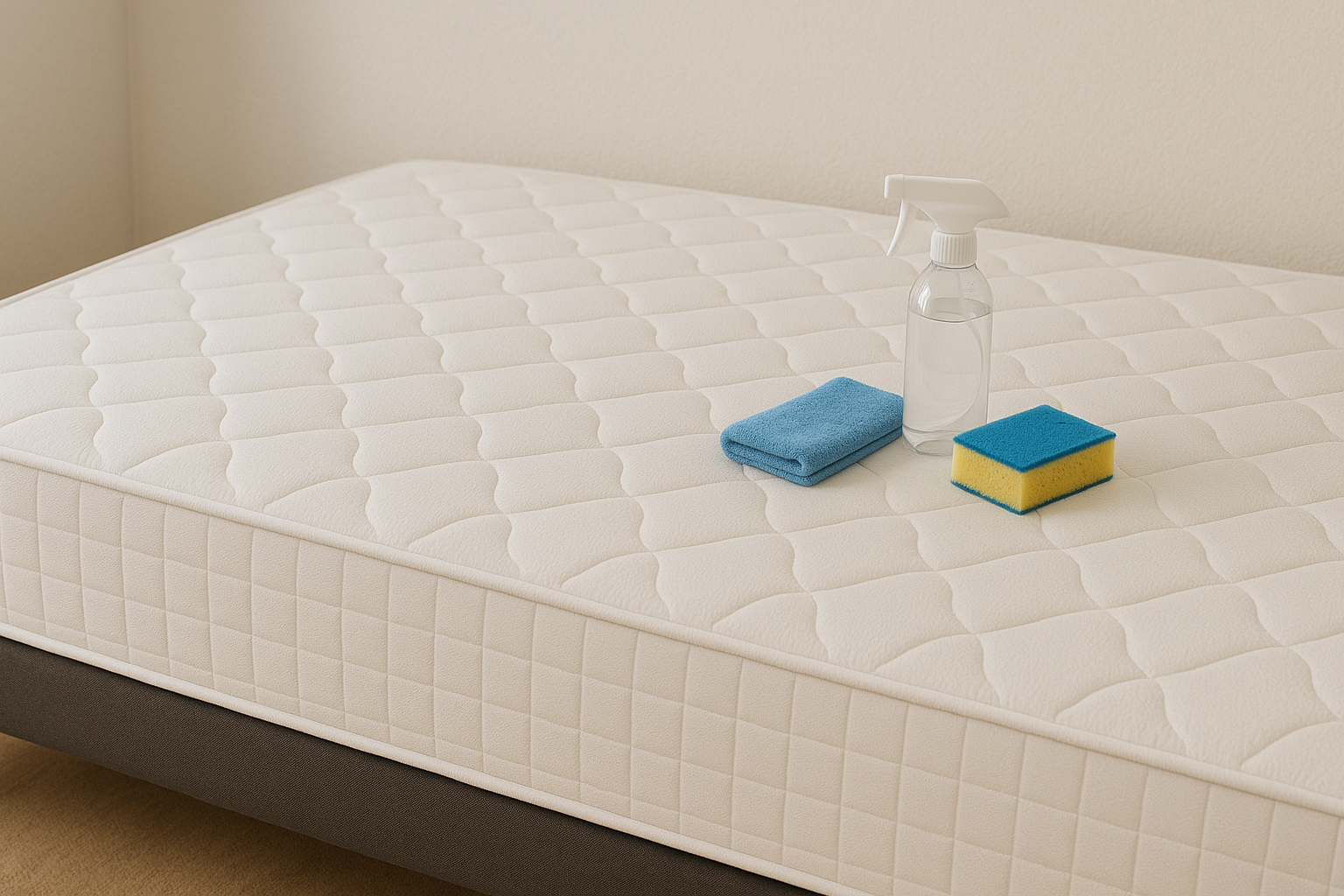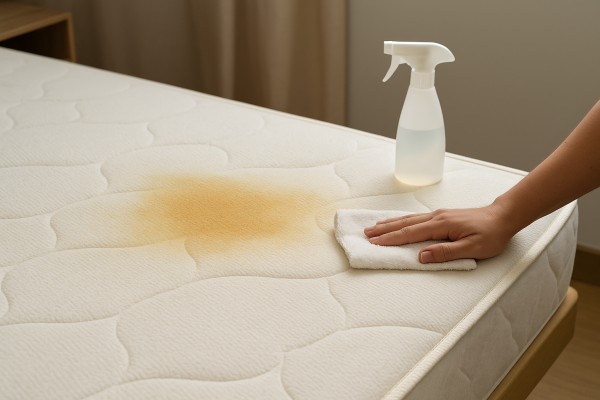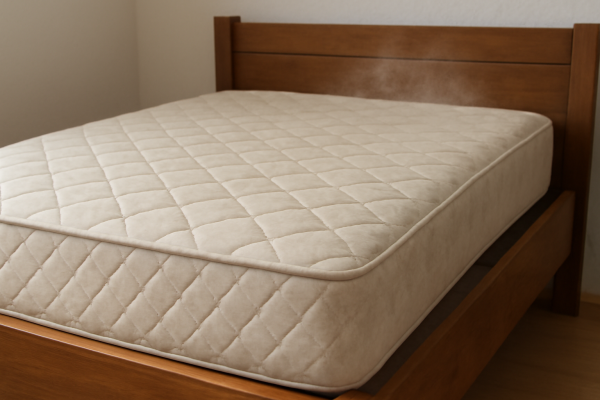Blood stains on your mattress? Don’t panic – you’re definitely not alone. Whether it’s from a nosebleed, a small cut, or period stains, blood on your mattress is more common than you might think. The good news? Most blood stains can be completely removed if you know the right techniques and act quickly.
The key to successfully removing blood from your mattress is understanding that fresh stains are much easier to tackle than dried ones. But even if you’ve discovered an older stain, there are still effective methods to get your mattress looking (and smelling) fresh again. This guide will walk you through everything you need to know about how to get blood out of mattress safely, without damaging your investment.
What to Do Immediately for Fresh Blood Stains
Time is your best friend when dealing with fresh blood stains. Here’s what you need to do right away:
- Blot, don’t rub. Grab a clean, dry towel or paper towels and gently blot the stain to absorb as much blood as possible. Rubbing will only push the blood deeper into the mattress fibres and spread the stain.
- Use cold water only. Hot water will actually set the blood proteins, making the stain permanent. Dampen a clean cloth with cold water and continue blotting from the outside of the stain inward.
- Sprinkle baking soda (optional but helpful). If you have baking soda handy, sprinkle a generous amount over the damp area. It’ll help absorb moisture and odours while you prepare your cleaning solution.
Remember, the sooner you tackle how to get blood stains out of mattress, the better your chances of complete removal. Even if you can’t clean it immediately, at least blot up the excess and keep the area damp with cold water until you can properly treat it.
Step-by-Step: How to Remove Blood from a Mattress
Method 1: Baking Soda + Cold Water Paste
Best for: Fresh stains and gentle cleaning What you’ll need: Baking soda, cold water, clean cloths.
This is your go-to method for fresh blood stains, especially on delicate mattress materials.
- Mix 2 tablespoons of baking soda with just enough cold water to form a thick paste
- Apply the paste directly to the stain, covering it completely
- Let it sit for 30 minutes to absorb the blood and moisture
- Gently scrape off the dried paste with a spoon or blunt knife
- Blot any remaining residue with a damp cloth
- Allow the area to air dry completely before making the bed
Method 2: Hydrogen Peroxide + Dish Soap + Salt
Best for: Stubborn or dried blood stains What you’ll need: 3% hydrogen peroxide, liquid dish soap, salt, spray bottle.
This method is highly effective but should be tested on a small, hidden area first as hydrogen peroxide can lighten fabrics.
- Mix 1 tablespoon liquid dish soap, 1 tablespoon salt, and ¼ cup hydrogen peroxide
- Apply the mixture directly to the stain
- Let it foam and bubble for about 10 minutes (this reaction helps lift the blood)
- Blot with a clean, damp cloth to remove the mixture
- Rinse the area with cold water and blot dry
- Repeat if necessary, then air dry completely
Warning: Only use this method on white or very light-coloured mattresses, as hydrogen peroxide may cause discolouration.
Method 3: Enzyme Cleaners (Commercial Solutions)
Best for: Period stains and biological matter What you’ll need: Commercial enzyme cleaner (available at most Australian supermarkets).
Enzyme cleaners are specifically designed to break down proteins in biological stains, making them perfect for blood removal.
- Follow the product instructions for dilution (if required)
- Spray or apply the cleaner to the stained area
- Allow it to sit for the recommended time (usually 10-15 minutes)
- Blot with a clean cloth – don’t oversaturate foam mattresses
- Rinse lightly with cold water if the product requires it
- Air dry thoroughly
Method 4: Meat Tenderiser (Natural Enzyme Alternative)
Best for: Tough, dried stains on white mattresses What you’ll need: Unseasoned meat tenderiser powder, cold water.
This might sound odd, but meat tenderiser contains natural enzymes that break down proteins – including blood.
- Mix 1 tablespoon meat tenderiser with enough cold water to make a paste
- Apply to the stain and let sit for 30 minutes
- Rinse with cold water and blot dry
- Repeat if needed
Note: Only use this on white fabrics as it may affect coloured materials.
Method 5: White Vinegar + Baking Soda
Best for: Natural cleaning and deodorising What you’ll need: White vinegar, baking soda, cold water.
This natural combination is gentler than hydrogen peroxide but may require multiple treatments.
- Pour white vinegar directly onto the stain and let it bubble for 30 seconds
- Blot with a clean cloth
- Sprinkle baking soda over the area and let sit for 10 minutes
- Vacuum up the baking soda
- Rinse with cold water and blot dry
How to Clean Blood from Specific Mattress Types
Not all mattresses are created equal, and different materials require different approaches when learning how to remove blood from mattress safely.
- Memory Foam Mattresses: Never soak memory foam! Always blot gently and use minimal liquid. The foam can trap moisture, leading to mould and mildew. Stick to the baking soda paste method or use enzyme cleaners sparingly.
- Latex Foam: Similar to memory foam, latex shouldn’t be oversaturated. Use a barely damp cloth with mild cleaner and ensure thorough air drying.
- Innerspring Mattresses: These are the most forgiving when it comes to cleaning. You can use slightly more liquid and deeper cleaning methods since the coils allow for better air circulation.
- Hybrid Mattresses (like Onebed X 12”): Treat these like memory foam on the comfort layer side. Be extra careful not to let moisture seep down to the coil layer, which could cause rust or damage.
Pro tip: Regardless of your mattress type, always use a waterproof mattress protector. It’s much easier to wash a protector than to clean your actual mattress!
When the Stain Still Won’t Come Out
Sometimes, despite your best efforts, a blood stain might prove stubborn. Here’s what to do:
- Try again: Most cleaning methods can be safely repeated 2-3 times. Just ensure the mattress is completely dry between attempts.
- Consider a mattress topper: A high-quality mattress topper can cover persistent stains while adding extra comfort to your sleep surface.
- Know when to replace: If you’re dealing with a very old mattress or multiple large stains, it might be more cost-effective to invest in a new mattress rather than continuing to battle stains.
Mattress Care & Prevention Tips for All Sizes
Whether you’re maintaining a Single mattress in a child’s room or a King size mattress in the master bedroom, proper care extends your mattress life significantly.
For Australian families: Double, Queen and King mattress sizes are the most popular choices, but they’re also the most expensive to replace. Protecting these larger investments with quality mattress protectors is essential.
Onebed mattresses – including the Onebed Original Gen3, Onebed Modular 12″, and Onebed X 12” – are built with premium materials and durable covers, but they still benefit from protective care. The adjustable firmness layers in Onebed mattresses make them particularly worth protecting, as replacement layers can be costly.
Prevention tips:
- Use a waterproof mattress protector (wash monthly)
- Rotate your mattress every 3-6 months
- Allow mattresses to air out after cleaning
- Keep pets off the bed if they’re prone to accidents
- Address spills and stains immediately
For women: Period stains are completely normal, but using dark-coloured sheets during your cycle and keeping a mattress protector can save you stress and cleaning time.
Frequently Asked Questions
Can I use hydrogen peroxide on all mattress types?
Hydrogen peroxide is safe for most mattress materials but can lighten or discolour fabrics. Always test on a hidden area first, and avoid using it on coloured or dark mattresses. Memory foam and latex should be treated with extra care to avoid oversaturation.
What removes blood from a mattress quickly?
For fresh stains, cold water and immediate blotting work fastest. For dried stains, hydrogen peroxide mixed with dish soap typically provides the quickest results, though enzyme cleaners are gentler and often more effective for biological stains.
Are period stains permanent on mattresses?
No, period stains aren’t permanent if treated properly. Fresh period stains respond well to cold water and baking soda, while older stains may need enzyme cleaners or hydrogen peroxide treatment. The key is using the right method for your mattress type.
Will a mattress protector stop stains from soaking in?
Yes, a quality waterproof mattress protector creates a barrier that prevents liquids from reaching your mattress. Look for protectors that are both waterproof and breathable to maintain comfort while providing protection.
How do I dry a mattress after cleaning it?
Always air dry mattresses naturally. Use fans to improve air circulation, open windows for ventilation, and ensure both sides of the mattress are completely dry before making the bed. Never use heat sources like hair dryers, as they can damage foam materials.
Keep Your Mattress Fresh and Protected
Most blood stains can be successfully removed with the right approach and quick action. Remember, fresh stains are always easier to tackle than dried ones, so don’t put off cleaning when accidents happen.
The best strategy? Prevention. A good mattress protector costs a fraction of what you’d spend on professional cleaning or mattress replacement, and it keeps your sleep surface hygienic and comfortable for years to come. If you’re tackling tougher spots, make sure to check our separate articles on removing general stains and urine stains for targeted tips.
Ready to protect your sleep investment? Whether you’re caring for a current mattress or considering an upgrade, explore Onebed’s full range of Single to King size mattresses. Built with premium materials, designed for easy maintenance, and backed by Australia’s longest trial period, Onebed mattresses are crafted to provide years of comfortable, worry-free sleep.





























